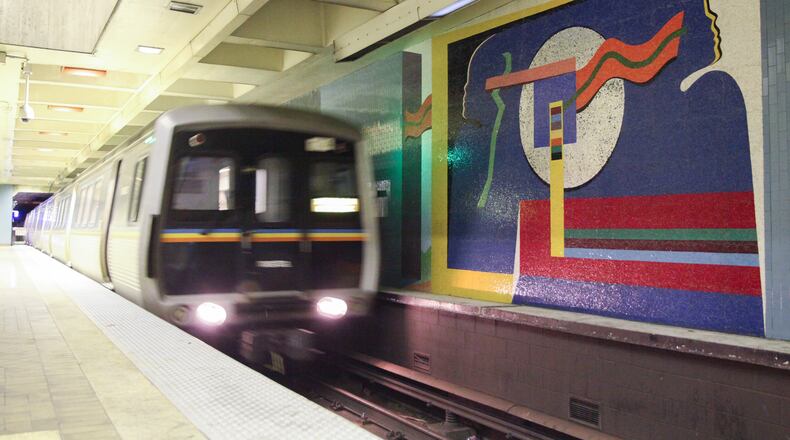An Ashby station MARTA worker who has been working there 13 years said she had never noticed the mosaics on the walls until recently, she told Katherine Dirga, MARTA's new arts administrator. The restoration of the mosaic artwork in the station is a result of efforts MARTA's public art program Artbound, officially launched June 19.
"I feel like transit is what Atlanta's future progress hinges on," Dirga said at a recent event at the Atlanta Contemporary art center.
And although the city's public transportation system lags those of similar cities, "Art can make transit a little bit enjoyable," she said.
MARTA riders may have already noticed some new features at stations, including murals at the Chamblee and King Memorial stations and a mural and playground at the West Trinity Bridge in Decatur. A mural is also being added to the Hamilton E. Holmes station.
Other riders, like the Ashby station worker, may have noticed work to restore existing art, including the 18 murals at the North Avenue station. "We want to make customers feel valued, and we can do that by bringing a little bit of humanity into the stations," Dirga said. "But a big part of enhancing riders' experience is just cleaning up what's already there."
According to Dirga, new plans include:
A lighting project for the Grant Street underpass, which will improve brightness and increase safety for pedestrians heading to the King Memorial station.
Forty-foot murals at the Decatur station.
Cleaning up existing artwork and adding low-maintenance landscaping to the East Point station.
Opening up the Airport station by clearing out unnecessary kiosks, enlarging an existing sculpture and adding artwork — which could be digital, kinetic or mosaic, Dirga said.
To fund those projects, 1 percent of the $453.3 million for the 2017 fiscal year will be allocated for art-related programs, community activities and restoration projects.
But not everyone thinks spending money on art should be a high MARTA priority. Mandel Jones, 23, of Fayetteville, says the biggest focus should be expanding MARTA and increasing its reliability. That sentiment was also expressed among Georgia legislators earlier this year when House Speaker David Ralston stated his support for deeper investment in mass transit.
Yet Jones said he sees the value in adding art. "It could change the way people perceive their stations and how they act on MARTA," he said.
Sandra Bloodworth, director of the Metropolitan Transit Authority's Arts & Design program in New York City, believes Jones' theory is correct. "When people see things that are broken, they'll break it more," Bloodworth said. "So the idea is, when you include great art (in public transportation) people will take good care of it. And for the most part they do."
For Dirga, who previously served as the art program manager for Hartsfield-Jackson International Airport, the hope is that by including art, especially art that reflects local communities, MARTA customers will feel a sense of pride in their city's transit system. "We want people to embrace the idea of there being a 'destination within the journey,' " she said.
Artbound soon plans to expand from visual art into the performing arts, Dirga said. On Sept. 13 and 14, MARTA will hold public music auditions for its Talent on Track program to have musicians play and perform in different stations. This is similar to MTA's Music Under New York program, which hosts over 7,500 performances throughout the transit system annually.
More details are expected to be released soon.
About the Author
Keep Reading
The Latest
Featured


